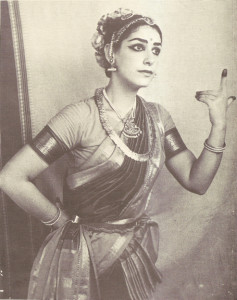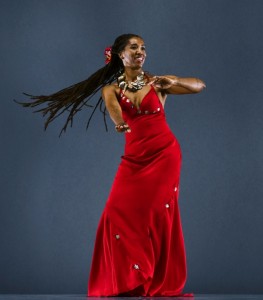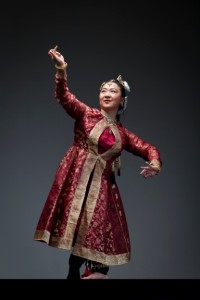FOR ALMOST TWO DECADES I have been trained in Kathak, a classical dance of North India, under the tutelage of my GuruJi, Pandit Chitresh Das. Taking his class for the first time as an 18-year old at San Francisco State University, I was introduced to the form alongside others of various ethnicities and cultures. I had zero experience with Indian dance, but I remember naively thinking, “Well, I look the part.” I was quickly awakened to the fact that art does not belong to the people of the culture, and in fact it is preserved by those who choose to uphold it through the practice of maintaining the technique, the traditions, the philosophies and the cultural contextualization from which it all stems. This requires a deep sensitivity and desire for studying the many influences that have developed these dance forms.
Simply, there are no shortcuts in studying and attempting to preserve a traditional dance form, regardless of your ethnicity. Inspired by the many individuals who have found connections and lifelong commitments to forms outside of their own ethnicities and cultures, I chose to speak with three artists who have given their lives to practicing and performing culturally specific dance forms that they were not born into, and are passing on the respective traditions to future generations. Their stories are a reminder that with an open mind and heart, focus and discipline—and a clear intention—no path is unattainable.

In 1963, at the age of 18, Bharatnatyam Guru, Katherine Kunhiraman (KatherineJi respectfully) moved to India, as her stepfather was offered a job as a consultant with the Ford Foundation to work in Kolkata, India. KatherineJi recalls her mother saying, “Just let India happen to you!”
KatherineJi’s interests included ancient history, theatre and religion, and found all these interests well met in India, where the ancient theatre had evolved into many forms of dance. She remembers how moved she was watching a Bharatanatyam performance: “The theatrical expressions, stunning delicate movements and detailing of each step left me awestruck. There and then I decided I wanted to learn [Bharatanatyam] and somewhere in my heart I was confident that I could do it. When I told my parents this, they were dumbfounded. But they allowed me to follow my heart.”
KatherineJi went on to study and train at the prestigious Kalakshetra in Chennai (formerly Madras), where she also began her performance career. Her mother would attend her performances and overhear Indian audience members question one another when seeing KatherineJi come on stage, “Now what is she going to do?” After witnessing her skill of movement and expression, the same audience members would applaud and make great vocal exclamations about her talent. Prejudice was clearly at play, but KatherineJi let it roll off her, relying on her knowledge and skills to maintain her confidence.
At Kalakshetra, KatherineJi also met and married her Kathakali master, KunhiramanJi, and had a daughter. In 1975, they moved to Berkeley to establish their own school, Kalanjali.
As the Indian population slowly started to grow in the U.S., so did their number of students. KatherineJi recalls there being some skepticism about a non-Indian woman teaching Bharatanatyam, but says that, “Once they knew me, and could get a sense of my knowledge, they stayed and helped to spread the word about our school.” KatherineJi had students of non-Indian origin and would encourage them to also seek performance opportunities, however, they were often turned away.
This saddened KatherineJi, but it didn’t stop her. “My interest was to be a preservationist, not a creator. As an Indian dancer, I was more interested in preserving and passing on the tradition of which I had learned and been trained in. I don’t feel like a non-Indian, I feel like I’m both—I’m at home with both cultures.

Photo by: RJ Muna
Mahealani Uchiyama (Mahea for short) is a dancer, musician, composer and teacher. An advocate for cultural understanding, she is the founder and Artistic Director of the Center for International Dance (MUCID), and is Kumu Hula (hula teacher) of Halau KaUaTuahine.
Born in Washington D.C. at the height of the civil rights era, at a young age, Mahea was introduced to ballet lessons. Loving the discipline of the dance and how it gave her a centering point that allowed her to relate to the rest of her life, Mahea recalls, “When things got me down dance helped me make sense of the world.” At 11 years old Mahea was already six feet tall and remembers that not many black women were ballet dancers, and none were as tall as she was, but the only options for dance classes were modern, jazz or ballet. At the age of 12, Mahea came across Hawaiian dance known as Hula, meaning dance in Hawaii ‘olelo Hawai’I, the language of the Hawaiian people.
When it came time to make decisions about college, Mahea struck a bargain with her parents so that she could go to college in Hawaii and pursue her study of Hula. At the age of 17, Mahea enrolled at the University of Hawaii and started taking classes in everything “Hawaiian” that she could.
Mahea recalls her experiences during that period: “Most of the black people in Hawaii were in the military, and I did not have problems with the ethnic Hawaiians, but they were not in power. It was the other locals that would say, ‘Gosh, she is so graceful/pretty/smart for a ‘colored’ girl.’ This began to wear on me.”
Mahea struggled to find a Kumu, as she was systematically excluded from the communities she tried to belong to. It became clear that though she loved the culture, she would never be fully accepted there. She had spent the entire time in Hawaii learning the language, the culture—everything she could do to make it clear that she was capable of this path—but it wasn’t until she moved to California that she found her Kumu, Joseph Kaha’ulelilo.
“He [Kumu] saw me with his heart.” Accepting of Mahea’s physical differences and most importantly saw that, “My whole heart was in this and my deep commitment to this art and to this culture.”
When Mahea’s Kumu passed, she was struck with the realization that Hula is a community-based form. It is meant to be a group of people moving with the vision of the Kumu. She felt compelled to start sharing the form, so she started offering classes.
Mahea describes Hula and her commitment to the culture and tradition: “This is a dance that relates to the earth, and basically places you as an intrinsic part of something bigger than you are, and gives a medium to become part of that, gives you an understanding that you’re not alone, that if you just slow down enough to regard nature— it is a rich gift, but only if you see yourself as part of it, but not as someone who can control it or own it. The underlying foundation is that of a very intense and profound spiritual attachment to the creator and the natural world, and to your community—if you don’t understand that, you can’t call yourself a hula dancer. A true Hula dancer is in service of the art, the culture, the tradition.“
Now celebrating 20 years of her organization, Mahea teaches people of Hawaiian descent as well as many other ethnicities. As a non-Hawaiian, she feels that it is not her place to get too far away from the core of the tradition, so tries to stay very much on the path she started on, one which is deeply connected to the tradition of Hula. She feels that people know and recognize the integrity of her traditional work.

Photo credit: Margo Moritz
Seibi Lee, disciple of Pandit Chitresh Das, grew up in Canada, and is half Chinese, half Japanese. Over 20 years ago she attended a Kathak performance and remembers being blown away by the range of technique. Studying to be a professional harpist at the time, she sought out the director of Pandit Das’ school in Toronto, to receive information on taking Kathak classes. For Seibi, her first class happened to be with Pandit Das himself and she was struck by the fact that her presence as a non-Indian was never questioned. “The way he taught was such that every person in the room had potential, and made the art feel universal.”
In the mid-90’s, Seibi moved to California so she could deepen her study with PanditJi, and shortly thereafter joined his company, Chitresh Das Dance Company, and is now a senior instructor at his institution, Chhandam, and a Kathak soloist in her own right.
For the past year, Seibi has been an Artist in Residence at the Oakland Asian Cultural Center where in October she will perform a traditional Kathak solo. Her storytelling segment of this performance will be the story of Houyi and Chang’e, an ancient Chinese story told through Kathak. The story will bring together certain aspects of Seibi’s life: her in-depth training as a Kathak dancer and western classical musician, and her Asian background and cultural heritage.
“The desire to explore my own cultural heritage has deepened over many years of studying Kathak with GuruJi (Pandit Das). He challenges us to respect and explore each of our own unique cultural histories. When I was growing up, I didn’t identify very strongly with my own Asian heritage because there was no community around me. The irony is that I am embracing a dance form from another culture, I am finding ways to pay homage to my own rich heritage.”
There are many artists like KatherineJi, Mahea and Seibi that have become true bearers of traditions. Their unwavering commitments have brought them to where they are today and through their artistry and teaching they are helping to preserve traditions for generations to come. No matter your cultural background, it’s important to follow one’s own dreams and aspirations as well as honoring the work of teachers, mentors, Kumus and Gurus, by remembering that art does not belong to any one person, it is a universal medium that has the power to inspire.
This article appeared in the October 2013 issue of In Dance.

